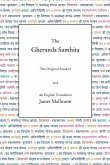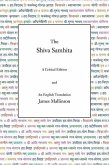It is said that Gherä¿a Samhit¿ was composed in the Seventeenth Century by Sage Gherä¿a. Not so much is known regarding his time and place of birth. His system of yoga is called 'Sapt¿¿ga Yoga' i.e. the yoga of seven limbs or parts. We know 'A¿¿¿¿ga Yoga' (i.e. the eight limbs of yoga) by Sage Patañjali and '¿ä¿¿ga Yoga' (i.e. the six limbs of yoga) by Guru Gorakhan¿th. All these systems of yoga with their specific limbs/parts are equally respected and followed in the yogic tradition. The first aspect of yogic practice described in Gherä¿a Samhit¿ is ¿äkarma, the six yogic cleansing practices. Their practice is important to get rid of diseases from the body and purify it properly. The second aspect of yogic practice discussed is the ¿sana. The importance of ¿sana practice is that they help create firmness and stability in the body. The third aspect of practice described is the mudr¿ which is used to control the flow of pr¿¿a and retain and circulate it within the body. The fourth aspect of practice he talked is praty¿h¿ra. According to Sage Gherä¿a, when body is purified through ¿äkarma, it is made firm and stable by ¿sana and pr¿¿a is controlled and retained by mudr¿, then one can naturally do the practice of praty¿h¿ra. The fifth aspect of practice he taught is pr¿n¿y¿ma. In most of the pr¿n¿y¿ma practices he included mantras with them. Practice of pranayama with specific mantras creates direct impact on energy field within the body and mind through the vibrations of the mantras which eventually contribute for the expansion of awareness. The sixth aspect of discourse in Gherä¿a Samhit¿ is dhy¿na. The state of dhy¿na arises naturally when the body is pure, firm and stable, pr¿¿a is controlled and the mind is withdrawn within itself. It describes three types of dhy¿na for developing awareness and one-pointedness of the mind. The seventh and final aspect described in Gherä¿a Samhit¿ is sam¿dhi. Its achievement is the final goal of yoga.
Hinweis: Dieser Artikel kann nur an eine deutsche Lieferadresse ausgeliefert werden.
Hinweis: Dieser Artikel kann nur an eine deutsche Lieferadresse ausgeliefert werden.









